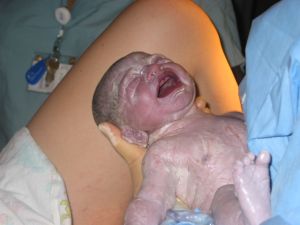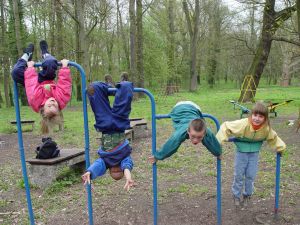From Lamaze International
 Despite best evidence, health care providers continue to perform routine procedures during labor and birth that often are unnecessary and can have harmful results for mothers and babies.
Despite best evidence, health care providers continue to perform routine procedures during labor and birth that often are unnecessary and can have harmful results for mothers and babies.
The Centers for Disease Control and Prevention’s (CDC) most recent release of birth statistics reveals that the rate of Cesarean surgery, for example, is on the rise to 31.1 percent of all births — 50 percent greater than data from 1996. This information comes on the heels of The Milbank Report’s Evidence-Based Maternity Care, which confirms that beneficial, evidence-based maternity care practices are underused in the U.S. health care system.
What the Research Says
Research indicates that routinely used procedures — such as continuous electronic fetal monitoring, labor induction for low-risk women, and Cesarean surgery — have not improved health outcomes for women and, in fact, can cause harm. In contrast, care practices that support a healthy labor and birth are unavailable to or underused with the majority of women in the United States.
Suggested Labor and Delivery Practices
Beneficial care practices outlined by Evidence-Based Maternity Care, a report produced by a collaboration of Childbirth Connection, the Reforming States Group, and the Milbank Memorial Fund, could have a positive impact on the quality of maternity care if widely implemented throughout the United States. Suggested practices include to:
- Let labor begin on its own.
- Walk, move around, and change positions throughout labor.
- Bring a loved one, friend, or doula to support you.
- Avoid interventions that are not medically necessary.
- Choose the most comfortable position to give birth and follow your body’s urges to push.
- Keep your baby with you — it’s best for you, your baby and breastfeeding.
“Lamaze is alarmed by the current rate of Cesarean surgery, and furthermore, by the overall poor adherence to the beneficial practices outlined above in much of the maternity care systems in the United States,” said Pam Spry, president of Lamaze International, www.lamaze.org. “We are continuing to work to provide women and care providers with evidence-based information to improve the quality of care.”
Lamaze International has developed six care practice papers that are supported by research studies and represent “gold-standard” maternity care. When adopted, these care practices have a profound effect –instilling confidence in the mother, and facilitating a natural process that results in an active, healthy baby. Each one of the Lamaze care practices is cited in the Evidence-Based Maternity Care report as being underused in the U.S. maternity care system.
A Need for Balance
“As with any drug, we need to be sure that women and their babies receive the right dose of medical interventions. In the United States we are giving too high a dose of Cesarean sections and other medical interventions, which are causing harm to women and their babies. Yet, there are many countries where life-saving medical interventions are under dosed, which can also cause harm,” said Debra Bingham, chair of the Lamaze International Institute for Normal Birth. “Every woman and her baby needs and deserves the right dose of medical interventions during childbirth.”
The research is clear, when medically necessary, interventions, such as Cesarean surgery, can be life-saving procedures for both mother and baby, and worth the risks involved. However, in recent years, the rate of Cesarean surgeries cause more risks than benefits for mothers and babies.
The Danger of Cesarean Sections
Cesarean surgery is a major abdominal surgery, and carries both short-term risks, such as blood loss, clotting, infection and severe pain, and poses future risks, such as infertility and complications during future pregnancies such as percreta and accreta, which can lead to excessive bleeding, bladder injury, a hysterectomy, and maternal death.
Cesarean surgery also increases harm to babies including women giving birth prior to full brain development, breathing problems, surgical injury and difficulties with breastfeeding.
About Lamaze International
Since its founding in 1960, Lamaze International has worked to promote, support and protect normal birth through education and advocacy through the dedicated efforts of professional childbirth educators, providers and parents. An international organization with regional, state and area networks, its members and volunteer leaders include childbirth educators, nurses, midwives, doulas, lactation consultants, physicians, students and consumers. For more information about Lamaze International and the Lamaze Institute for Normal Birth, visit www.lamaze.org.

 According to an article on SeattlePI.com, “Unemployed Dads Work to Find Their Place at Home,” the economic recession-spurred unemployment rate — expected to hit double digits in the United States — could be accelerating a shift in the breadwinner/stay-at-home roles of the family.
According to an article on SeattlePI.com, “Unemployed Dads Work to Find Their Place at Home,” the economic recession-spurred unemployment rate — expected to hit double digits in the United States — could be accelerating a shift in the breadwinner/stay-at-home roles of the family. Adverse experiences early in life can lead to minor childhood behavior problems, which can grow into serious acts of teen violence, according to new research. This “cascading effect” of repeated negative incidents and behaviors is the focus of an article in the November/December 2008 edition of Child Development.
Adverse experiences early in life can lead to minor childhood behavior problems, which can grow into serious acts of teen violence, according to new research. This “cascading effect” of repeated negative incidents and behaviors is the focus of an article in the November/December 2008 edition of Child Development. According to an article on Guadian.co.uk, “Postnatal Depression and Your Baby,” the length of a new mother’s postpartum depression has a strong tie with the difficulties she’ll experience in establishing a close attachment with her baby.
According to an article on Guadian.co.uk, “Postnatal Depression and Your Baby,” the length of a new mother’s postpartum depression has a strong tie with the difficulties she’ll experience in establishing a close attachment with her baby. People talk about the “problem child,” but I’m not really sure what a problem child is.
People talk about the “problem child,” but I’m not really sure what a problem child is. Depression — a mental illness marked by unrelenting sadness and hopelessness that permeates the lives of an estimated one in 18 people — is among the most prevalent medical disorders in today’s world, affecting 12 percent of women, 7 percent of men, and 4 percent of adolescents in a given year. Eight percent of adults will develop depression sometime in their life, and women are most prone — their lifetime risk is 20 percent.
Depression — a mental illness marked by unrelenting sadness and hopelessness that permeates the lives of an estimated one in 18 people — is among the most prevalent medical disorders in today’s world, affecting 12 percent of women, 7 percent of men, and 4 percent of adolescents in a given year. Eight percent of adults will develop depression sometime in their life, and women are most prone — their lifetime risk is 20 percent. Dahlia was running around the house screaming and crying. “I hate her! I hate her! I will never play with her again!”
Dahlia was running around the house screaming and crying. “I hate her! I hate her! I will never play with her again!” Despite best evidence, health care providers continue to perform routine procedures during labor and birth that often are unnecessary and can have harmful results for mothers and babies.
Despite best evidence, health care providers continue to perform routine procedures during labor and birth that often are unnecessary and can have harmful results for mothers and babies. A January 6 article in the United Kingdom’s Nursery World magazine, “A Unique Child: Attachment – Practice in Pictures – A Sense of Security,” illustrates the difference between a securely and insecurely attached child.
A January 6 article in the United Kingdom’s Nursery World magazine, “A Unique Child: Attachment – Practice in Pictures – A Sense of Security,” illustrates the difference between a securely and insecurely attached child. The Public News Service published an article featuring API Co-founder Lysa Parker’s perspective on U.S. President Barack and First Lady Michelle Obama’s family values.
The Public News Service published an article featuring API Co-founder Lysa Parker’s perspective on U.S. President Barack and First Lady Michelle Obama’s family values.